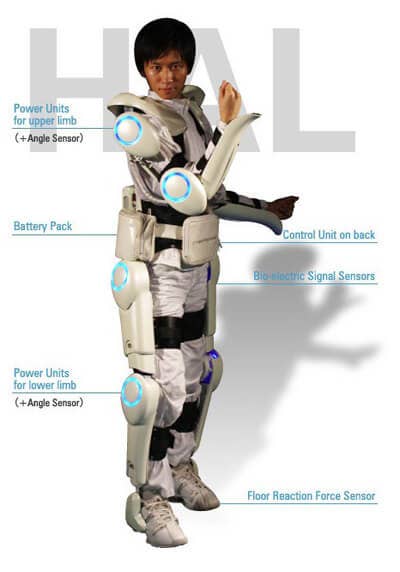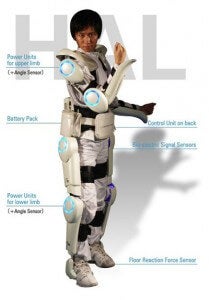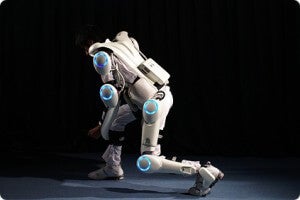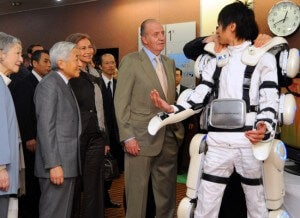Cyberdyne Ready to Mass Produce Cyborgs

Share
Nothing transforms scientific gurus into excited SciFi geeks quicker than the mention of a robotic exoskeleton. Iron Man, RoboTECH, Exosquad, Starship Troopers (the book), Neon Genesis Evangelion, Aliens and a thousand other pieces of entertainment have convinced us of one thing: robotic suits = awesome. Professor Yushiyuki Sankai, founder of the Japanese robotics company Cyberdyne, is unabashedly a fan of science fiction, and he now sits on the cusp of bringing that awesomeness into our everyday lives.

Cyberdyne's new Robotic Suit HAL strikes a dashing pose, completely fitting with its Japanese SciFi pedigree.
Cyberdyne has developed Robotic Suit HAL, a 50 lb exoskeleton that easily fits over an adult body and augments strength and stability. HAL, short for Hybrid Assistive Limb, completely supports its own weight and balances itself, allowing the user to move freely and lift objects two to ten times heavier than he or she could alone. The glowing discs in the diagram are actually motors providing the necessary forces. Its rechargeable 100 Volt ACDC power source will run for five hours for normal activity. Sensors along joints read motor neuron impulses telling HAL when and how to move. No complicated controls are necessary. This means that anyone can strap on HAL and be walking about in just a few minutes.

Cyberdyne's Robotic Suit is capable of a wide range of stable movement
Much has been made of Cyberdyne's and Professor Sankai's accomplishments. He's recently made rounds of interviews in Japan, and was the focus of several major news stories. In the following video, make sure to wait, or skip ahead, to watch the actual performance of HAL as it moves and lifts.
The Cyborg Race
Cyberdyne isn't the only major corporation developing robotic suits or cyborg technology. Industrial giant Honda has produced a pair of mechanical legs. The MIT Biomechatronics Lab has done abundant research in the field and produced several prosthetics. Sarcos Inc. has been working on robotic suits for years with varying degrees of success. Each of these companies, and others, have made progress comparable to Cyberdyne.
What sets Prof. Sankai's accomplishments apart is the readiness of his product, and his own unique character. First, the Robotic Suit HAL is already available to select users in Japan. While the exact figures of that rental agreement ($1300/month or perhaps $4200 to buy) are not confirmed, the Cyberdyne website does say sales are beginning. A branch of the company was just opened in Amsterdam, and sales in the EU are set to begin soon. While most other companies are still perfecting their prototypes, Cyberdyne seems ready to produce the first commercially widespread cybernetic device.
Be Part of the Future
Sign up to receive top stories about groundbreaking technologies and visionary thinkers from SingularityHub.


"Some countries produce art and some countries produce agriculture, but Japan lacks the basic foundation for such things. So the people here improve technology." ---Prof. Yoshiyuki Sankai, 2008
Just as impressive as HAL, however, is Sankai's vision for the future. His work is largely inspired by his love of science fiction (such as the book I, Robot and the cartoon Cyborg 009). Sankai has a strong national pride, but with such an idealized background, it is no wonder that Sankai has insisted that his robotic suits will never be developed for military use. The intended consumer will be stroke victims, disabled people, and industrial workers. The same sensors that detect motor neuron signals on the skin's surface (an amazing feat in of itself) may be adapted to monitor vital signs and eventually help protect the user or call for help in case of emergencies. A vocabulary of complex movements can already be programmed into HAL in cases where users no longer have motor neuron signals to direct the device.
The 14th annual International Conference on Advanced Robotics (ICAR) is coming soon in June 2009, and Prof. Sankai is one of the invited speakers. Considering Cyberdyne's goal of making hundreds of HALs available in the upcoming year, we can hope for new details concerning its costs and availability. We should also expect to hear more about Sankai's vision on how humanity can be assisted, augmented, and improved by a little touch of awesomeness.
"By developing technology people are trying to take part in their own evolution." ---Prof. Yoshiyuki Sankai, 2008

HAL is demonstrated by one of Sankai's assistants.

Prof. Sankai posing with different versions of HAL.
Related Articles

These Robots Are the Size of Single Cells and Cost Just a Penny Apiece

In Wild Experiment, Surgeon Uses Robot to Remove Blood Clot in Brain 4,000 Miles Away

A Squishy New Robotic ‘Eye’ Automatically Focuses Like Our Own
What we’re reading